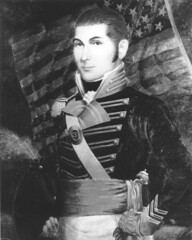 The Bear Flag Republic In California
The Bear Flag Republic In California
Most Europeans expected the United States to lose the Mexican War. The Mexican army was about four times the size of the U.S. Army, and the last time the United States had attempted an invasion of a foreign country-Canada in 1812-it had failed miserably. The Mexicans, however, fought poorly for the most part. General Taylor, a 62-year-old veteran of the War of 1812, easily defeated the Mexicans at Palo Alto and Resaca de la Palma north of the Rio Grande. He then crossed into Mexico, defeated the Mexican army at Matamoras, and seized the capital of Nuevo Leon, Monterrey, in September.
In support of Taylors campaign, the Navy blockaded the Mexican coast and launched a series of amphibious assaults on Mexico itself. Vice Commodore Matthew Perry, commander of the Gulf Coast Squadron, led an expedition including a 200-man unit of Marines under the command of Captain Alvin Edson, the Marine commander at Kuala Batu. The force captured Frontera and San Juan Bautista in October 1846, although it occupied neither city, and on November 14, it occupied Tampico unopposed.
The Mexican government knew that concession would almost certainly lead to revolution and refused to give in. Taylor's Army was unprepared to pursue the Mexican army across 400 miles of barren terrain to Mexico City, and the general agreed to a temporary armistice in which he pledged not to pursue the Mexicans. Polk then adopted a new strategy, proposed by General Winfield Scott, to conduct an amphibious assault on the port of Vera Cruz, which was only 200 miles east of Mexico City.
In the meantime, the declaration of the Bear Flag Republic in California and the formation of the California Battalion in July 1846 had acted as a catalyst for further hostilities. Commodore John Sloat, commander of the Pacific Squadron, had received reports that Mexicans and Americans were fighting in Texas. Fremont's obvious support of the Bear Flag revolt convinced him that it was time to invade California.
During the month between July 7 and August 6, 1846, the U.S. Navy peacefully occupied the cities of Monterey, San Francisco, Santa Barbara, and San Pedro. Leaving small Marine garrisons at each of these cities, the Pacific Squadron also delivered Fremont's California Battalion to San Diego, and on August 8, leaving Gillespie in San Diego with 50 men, Fremont marched at the head of a column of 120 men bound for Los Angeles, the provincial capital. On August 11, Commodore Stockton, having replaced the aging Sloat as commander of the pacific Squadron, led a column of 360 sailors and Marines from San Pedro also bound for Los Angeles. Fremont and Stockton both entered Los Angeles on August 13 completely unopposed, and the remaining Mexican troops surrendered the next day. California had been conquered in just six weeks.
But it didn't last. Stockton, as ranking officer, decided to divide California into three military districts and appointed Gillespie as commander of the southern district, headquartered at Los Angeles. But the regulations and curfew Gillespie instituted and the arrests he made soon antagonized the Californians.
On September 23, several hundred Californians surrounded Gillespie and his men at their headquarters in Los Angeles and Gillespie was forced to evacuate his men from the city under the promise to leave California from the port city of San Pedro. During the siege in Los Angeles, however, one of Gillespie's men had managed to sneak through the lines and deliver a message to Captain William Mervine in Monterey. Mervine arrived in San Pedro aboard the Savannah on October 6, and on the following day he set out for Los Angeles at the head of 225 sailors and Marines with Gillespie and his Bear Flaggers.
On October 8, Mervine encountered 130 mounted Californians protecting a single cannon. Although the U.S. forces had no artillery of their own, Mervine attempted to seize the Californians' gun. The Californians, however, prudently withdrew the cannon upon each time the Americans charged. After three attempts, Mervine finally decided that the operation was a failure and called for a retreat, with Gillespie's men offering covering fire for the retiring sailors and Marines. Mervine's unit retired to San Diego.
Commodore Stockton had begun to lay plans for a renewed assault on Los Angeles involving the Pacific Squadron and Fremont's California Battalion when he received amazing news: Brigadier General Stephen Kearny, commander of the Army of the West, which had only recently occupied New Mexico, had marched into California with a small escort of 100 dragoons and four cannons under the impression that the province was at peace. Gillespie set out immediately with 39 men to meet Kearny and direct him to San Diego.
Gillespie reached Kearny's column on December 5 and learned that a Californian cavalry unit was camped nearby. Kearny decided to attack the next morning. The Californians were outnumbered by two to one, but the American assault was confused, and the Californians proved to be better fighters than expected. Armed with cavalry lances, the Californians charged into the melee and tore apart the American troops, who were armed with swords.
Gillespie was struck from behind and unhorsed. He was struck twice more before he was finally able to drag himself to his feet and struggle out of the combat. He scrambled to the cannon and was able to fire one of them, after which the Californians retired. Nineteen Americans were killed and 15 were wounded at the Battle of San Pascual. Only one Californian had been captured, and perhaps another dozen were wounded. Kearny sent a messenger to San Diego requesting aid, and a relief column found the struggling unit on December 10.
In San Diego, Kearny and Stockton assembled a rag-tag force of some 600 sailors, Marines, dragoons, California Battalion members, and other volunteers. The force was organized into four divisions, one of which was commanded by Gillespie, still recovering from the wounds he had sustained in battle with the Californians on December 5. On December 28, the force set out and on January 8, 1847, it encountered a mounted Californian army at the San Gabriel River.
The Americans organized themselves into a square formation, with each of the four units facing outward from one of the sides of the square-a standard formation for infantry facing cavalry in the early nineteenth century, allowing the infantry to guard against an attack from any direction and began to ford the river. They immediately came under fire from two California cannon, and a unit of lancers began a charge at the left face of the American square.
The Americans struggled forward, and just beyond the river, set up their own cannon and returned fire. The more powerful American artillery stopped the lancers' charge, forcing the Californians to pull their own cannons back, and the American square resumed its advance. Most of the Californians pulled back with their guns, but the lancers made a wide circuit of the American square and attacked its rear face, where Gillespie's division was assigned. Gillespie's muskets stopped the lancers' second charge.
The Californians rallied their forces approximately one-half mile from their original position and brought their guns to bear upon the Americans once more. Again, however, the Americans' superior artillery forced the Californians to withdraw.
The next morning, the Americans resumed their march and soon encountered the remnant of the Californian army, which had suffered only about a dozen casualties during the engagement of the day before but which had been reduced to about 300 men by desertion. The Californians had deployed across La Mesa, a broad plain south of Los Angeles, in order to block the American advance.
The ensuing battle was to a large extent a replay of the previous encounters between the two armies: The lancers' charge was repulsed by musket fire, and the superior firepower of the American cannon forced the dwindling Californian army to retreat.
The American Army marched into Los Angeles on January 10, where Archibald Gillespie again raised the flag he had been forced to take down the previous September. Fremont arrived in Los Angeles four days later, having stopped to negotiate the surrender of the Californian army.
Sailors and Marines landed at San Jose del Cabo, San Lucas, and Loreto in Baja, and at Guaymas, San Blas, and Manzanillo in Mexico proper. Unopposed, each landing took just long enough to conclude conventions acknowledging American authority in those cities. In July, however, two companies of New York volunteers landed at and seized La Paz, the capital of the Baja province, and in November, the Navy seized Mazatlan, and two dozen Marines under the command of First Lieutenant Charles Heywood went ashore at San Jose. Although the Californians counterattacked three times at La Paz and twice at San Jose, the New Yorkers and Heywood's Marines were able to hold them off. Guaymas was assaulted four times between November 1847 and March 1848, but to no avail.
 Victory in Europe Day
Victory in Europe Day










